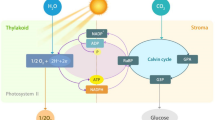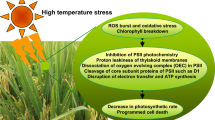Abstract
In the succulent leaves of Aloe arborescens Mill diurnal oscillations of the malic acid content, being indicative of Crassulacean Acid Metabolism (CAM), were exhibited only by the green mesophyll. In contrast, the malic acid level of the central chloroplast-free water-storing tissue remained constant throughout the day-night cycle. Apart from malate, the green tissue contained high amounts of isocitrat which was lacking in the water tissue. There was no significant transfer from the green mesophyll to the water tissue of 14C fixed originally via dark 14CO2 fixation in the mesophyll. Both isolated mesophyll and water tissue were capable of dark CO2 fixation yielding mainly malate as the first stable product. Both tissues have phosphoenolpyruvate carboxylase. However, the enzymes derived from the both sources could be distinguished by their molecular weights and by their kinetic properties, suggesting different phosphoenolpyruvate carboxylase proteins. The conclusion drawn from the experiments is that in a. arborescens the CAM cycle proceeds exclusively in the green mesophyll and that the water tissue, though capable of malate synthesis via β-carboxylation of phosphoenolpyruvate, behaves as an independent metabolic system where CAM is lacking. This view is supported by the finding that the cell walls bordering the green mesophyll from the water tissue lack plasmodesmata, hence conveniant pathways of metabolite transport.
Similar content being viewed by others
Abbreviations
- CAM:
-
Crassulacean acid metabolism
- PEP:
-
phosphoenolpyruvate
- PEP-C:
-
phosphoenolpyruvate carboxylase
References
Böcher, M., Kluge, M.: The C4-pathway of C-fixation in Spinacea oleracea. I. 14C-labeling pattern of suspended leaf slices as influenced by the external medium. Z. Pflanzenphysiol. 83, 347–361 (1977)
Crews, C.E., Williams, S.L., Vines, H.M., Black, C.C.: Changes in the metabolism and physiology of crassulacean acid metabolism plants grown in controlled environments. In: CO2 metabolism and plant productivity, pp. 235–250, Burris, R.H., Black, C.C., eds. Baltimore, London, Tokyo: University Park Press 1976
Denius, H.R., Homan, P.: The relation between photosynthesis, respiration, and Crassulacean Acid Metabolism in leaf slices of Aloe arborescens Mill. Plant Physiol. 49, 873–880 (1972)
Hohorst, H.J.: L-(--)-Malat, Bestimmung mit Malatdehydrogenase und NAD. In: Methoden der enzymatischen Analyse pp. 1544–1548, Bergmeyer, H.U., ed. Weinheim: Chemie 1970
Holdsworth, M.: Carbon dioxide uptake by succulents. Can. J. Bot. 49, 1520–1522 (1971)
Jones, R., Wilkins, M.B., Coggins, J.R., Fewsond, Ch.A., Malcolm, A.D.B.: Phosphoenolpyruvate carboxylase from the crassulacean plant Bryophyllum fedtschenkoi Hamet et Perrier: Purification, molecular and kinetic properties. Biochem. J. 175, 391–406 (1978)
Joshi, G.V., Bartakke, S.P.: Light and dark 14CO2 fixation in Aloe vera var. indica. Maharashtra Vidnyan Mandir Patrika 2, 22–28 (1974)
Kluge, M.: Is Sedum acre a CAM plant? Oecologia 29, 77–83 (1977)
Kluge, M., Fischer, K.: Über Zusammenhänge zwischen dem CO2-Austausch und der Abgabe von Wasserdampf durch Bryophyllum daigremontianum Berg. Planta 77, 212–223 (1967)
Kluge, M., Heininger, B.: Untersuchungen über den Efflux von Malat aus den Vacuolen der assimilierenden Zellen von Bryophyllum daigremontianum Berg. Planta 113, 333–343
Kluge, M., Kriebitsch, Ch., v. Willert, D.: Dark fixation of CO2 in Crassulacean Acid Metabolism: Are two carboxylation steps involved? Z. Pflanzenphysiol. 72, 460–467 (1974)
Kluge, M., Osmond, C.B.: Studies on phosphoenolpyruvate carboxylase and other enzymes of crassulacean acid metabolism of Bryophyllum tubiflorum and Sedum praealtum. Z. Pflanzenphysiol. 66, 97–105 (1972)
Kluge, M., Ting, I.P.: Crassulacean Acid Metabolism — Analysis of an ecological adaptation. Ecological Studies, vol. 30 Berlin, Heidelberg, New-York: Springer 1978
Knopf, O., Kluge M.: Properties of phosphonenol in Sedum species in relation to Crassulacean Acid Metabolism. Plant Cell and Environ. (in press)
Nuernbergk, E.L.: Über den zeitlichen Verlauf der Photosynthese bei Gewächshauspflanzen. Gartenbauwiss. 19, 391–398 (1955)
Willert, D.J. v., Kramer, D.: Feinstruktur und Crassulaceen-Säurestoffwechsel in Blättern von Mesenbryanthemum crystallinum während natürlicher und NaCl induzierter Alterung. Planta 227–237 (1972)
Author information
Authors and Affiliations
Rights and permissions
About this article
Cite this article
Kluge, M., Knapp, I., Kramer, D. et al. Crassulacean acid metabolism (CAM) in leaves of Aloe arborescens mill. Planta 145, 357–363 (1979). https://doi.org/10.1007/BF00388361
Received:
Accepted:
Issue Date:
DOI: https://doi.org/10.1007/BF00388361




